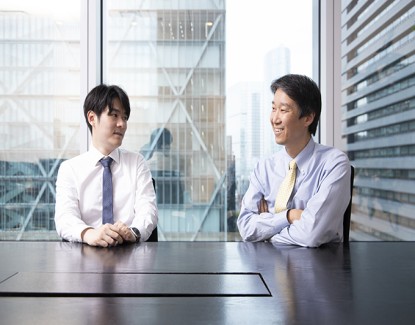Market Commentary and Fund Performance
Masa Takeda of Tokyo-based SPARX Asset Management Co., Ltd., sub-advisor to the Hennessy Japan Fund, shares his insights on the Japanese market and Fund performance.
-
 Masakazu Takeda, CFA, CMAPortfolio Manager
Masakazu Takeda, CFA, CMAPortfolio Manager
Performance data quoted represents past performance; past performance does not guarantee future results. The investment return and principal value of an investment will fluctuate so that an investor’s shares, when redeemed, may be worth more or less than their original cost. Current performance of the fund may be lower or higher than the performance quoted. Performance data current to the most recent month end, and standardized performance can be obtained by viewing the fact sheet or by clicking here.
Fund Performance Review
In November, the Fund increased by 7.16% (HJPIX), underperforming its benchmark, the Russell/Nomura Total MarketTM Index, which rose by 7.81%.
The month’s positive performers among the Global Industry Classification Standard (GICS) sectors included shares of Industrials, Information Technology, and Consumer Discretionary while Consumer Staples and Communication Services detracted from the Fund’s performance.
Among the best performers were our investments in Recruit Holdings., Japan’s unique print and online media giant specializing in classified ads as well as providing human resources services, Tokyo Electron Limited, a manufacturer of semiconductor equipment, and Shin-Etsu Chemical Co., Ltd., Japan’s largest chemical company.
As for the laggards, Rohto Pharmaceutical Co., Ltd., a leading skincare cosmetics and over-the-counter (OTC) ophthalmic medicines producer, Nissan Chemical Corporation, a manufacturer of liquid crystal alignment films and pesticide, and Socionext Inc., a fabless semiconductor vendor involved in the development, design and sales of custom SoC (system on a chip) were the largest detractors.
We are now entering the final month of the year. We would like to take this opportunity to reflect on the recent changes in the Fund portfolio and discuss our investment strategy for 2024 (and beyond).
Our approach to equity investment is very simple: “Invest in a great business with exceptional management at an attractive price.” In a capitalist world, companies operate with the capital entrusted to them by shareholders. In exchange, shareholders expect the companies to grow the capital they have entrusted. Companies create wealth through profits, and shareholders reap the benefits through rising stock prices and dividends.
Based on this fundamental principle, we identify companies that we would like to hold as shareholders for a long time and calculate their intrinsic value. We invest when the market price is below this intrinsic value and aim to maximize the returns by holding them for as long as possible.
Stocks can be described as “perpetual bonds with variable coupons.” Therefore, in most cases, the intrinsic value can be determined by predicting the future cash flows (i.e., coupons) that the business will generate for shareholders over the remainder of its life and discounting them back to its present value.
Therefore, the term “great business” centers on businesses that have high returns on capital (ROC) (as measured by return on equity (ROE)), return on invested capital (ROIC), return on capital employed (ROCE), etc.—have sustainable profit growth exceeding the average (global nominal gross domestic product (GDP) growth rate), and generate solid cash flow.
Here are the investment criteria (“seven-item checklist”) we use to identify promising investment candidates:
- Simple and intelligible business model
- Inherently sound and safe business
- A well-capitalized balance sheet with little debt
- Durable competitive advantage
- Above-average return on equity and earnings growth that are sustainable
- Consistent and ample cash-flow generator
- Run by exceptional management
Evolution of the portfolio
While the Fund is long-term oriented, looking back over the past 15 years, the composition of the portfolio has gradually changed. The brief history can be divided into three phases.
First phase: Late 2000s to mid-2010s
Second phase: Mid-2010s to 2021
Third phase: 2022 onwards
The overarching thesis of the first phase (late 2000s to mid-2010s) was “Japan’s manufacturing excellence.” Unlike the U.S., where giant tech companies dominate, Japan does not have too many globally competitive tech or consumer brands. However, with the country’s craftsmanship and its studious ethos as represented by “kaizen” and “just-in-time production,” Japan excels at manufacturing and exporting high-quality products all around the world. This should be considered as a sustainable competitive edge of Japanese companies, in our view.
To reflect this belief, we invested in companies such as Keyence (factory automation sensors), Shimano (high-end bicycle parts), Asics (sporting goods), Unicharm (diapers, sanitary products), Kao (FMCG), Ryohin Keikaku (clothing and household goods), Rohto Pharmaceutical (OTC eye drops, skin care cosmetics), Nidec (direct current brushless precision motors), Terumo (medical devices), and Misumi Group (precision machinery parts). When it comes to Japanese manufacturing, automobiles and capital goods would often come to mind, but we apply this concept to a broader universe including consumer goods, healthcare products, and apparel. For example, Japan-made diapers, running shoes, and vascular catheters all enjoy strong brand recognition globally thanks to their high-quality nature and functionality.
We have already exited from some of these investments after realizing outsized returns, while others are still held in the Fund in smaller sizes. Furthermore, even after the first phase, we have continued to invest in companies such as Fast Retailing (functional basic clothing) and Daikin Industries (energy-saving air conditioners) based on the same investment premise.1
In the second phase (mid-2010s to 2021), we shifted our focus to businesses with strengths in intangible assets. This is in response to the structural change we observed in modern capitalism where intangible assets held by tech platformers such as GAFAM (Google, Apple, Facebook, Amazon, Microsoft) were rapidly becoming the determinant of corporate financial performances. For these companies, the most important assets are not factories or stores, but software, algorithms, content, intellectual property, customer data, and network effects built on their online platform. These companies, which provide services that are used over a long time with high switching costs for users (individuals and corporations), are characterized by extraordinarily high returns on capital and high operating leverage, as well as huge total addressable markets. Even at the best-known high-quality businesses in the world, we often realize that these 3 dimensions seldom co-exist. Furthermore, the network effects of platform businesses are known to enhance the utility of the platform exponentially for the users making them less subject to the law of diminishing returns even as revenue scale increases.

In the Fund portfolio, Recruit Holdings (first investment in 2016) would fall under this category with its wide range of advertising media utilizing the Internet. The company runs Indeed Inc., the U.S. job search platform company as a wholly owned subsidiary. As a gaming ecosystem, Sony Group (first investment in 2019) owns the PlayStation franchise which enjoys network effects and boasts a rich content library through its music and movie businesses. Hitachi (first investment in 2021) is transitioning from a traditional hardware sales model to a business model (the Lumada business) that collects and analyses customer data and provides solutions to their industrial clients for monetization.
The third phase has begun just recently. Initially, we set out in 2022 with a view that the acceleration in global inflation that had begun a few quarters prior and the accompanying rise in interest rates would be transitory. Hence our strategy was to hold existing portfolio names and sit through the inflation “storm” at that time. In our view, the valuation premiums awarded to the majority of the then-portfolio holdings were well-justified given their superior returns on capital, promising growth prospects and balance sheet strengths, especially in Japan where the prevailing interest rates continued to remain ultra-low compared to overseas.
However, as time passed, it dawned on us that the inflation phenomenon and interest rate increases were not temporary. For the Japanese stock market, where the foreign investor participation ratio is almost 60% of daily turnover, the important valuation yardstick should not be domestic interest rates but overseas rates (i.e., U.S. treasury yields). Currently, the risk-free interest rates in the U.S. are hovering around 5% for both short (2yr) and long ends (30yr). It is not surprising to see U.S. dollar-based foreign investors finding risk-free bonds more attractive than risky assets like foreign stocks, which inherently come with higher future uncertainty.2 Thus, we have recalibrated our world view that “the coming decade of investment environment surrounding Japanese stocks may be very different from the past decade.” Though we came around to this realization somewhat belatedly (April-May of last year), it was a trigger for us to change the portfolio.3
In terms of portfolio changes since 2022, we first significantly increased the weighting of Mitsubishi Corporation, an existing holding, and subsequently added new positions in three mega-insurance groups (Tokyo Marine Holdings, MS&AD Insurance Group Holdings, Sompo Holdings), Orix, and Mitsubishi UFJ Financial Group for the year through 1Q2023. These stocks are generally referred to as “value stocks,” but we view them as “growth stocks in disguise” in the sense that they are under-appreciated by the stock market as above-average growers with attractive return profiles.
Unlike the “pure growth stocks” that made up the majority of the portfolio in the first and second phases, the appeal of “growth stocks in disguise” is as follows:
• Core earnings growth rates that exceed the nominal global GDP growth (albeit not as high as our “pure growth stocks”)
• Incremental growth in earnings per share (EPS) boosted by sustainable share buybacks
• High dividend yields
When these three sources of stock returns are added up, the expected annualized return could be double-digits. This is on par with the “pure growth stocks” or even better. In the case of “pure growth stocks,” even if the earnings growth is faster, generally high share price levels and reinvestment needs of the business prevent them from conducting sustainable share buybacks, or when they do, the positive impact is limited. For the same reason, the dividend yields are often below the market average. Therefore, the driver of stock returns relies almost entirely on the 10+% earnings growth.
In addition, under the new interest rate paradigm, we can no longer count on re-rating the valuation multiples seen during the low-interest-rate period of the 2010s. Interest rate is the gravity that affects the prices of all financial assets. With the yield spread between earnings yield and risk-free rate rapidly narrowing, we now lean towards “short duration” stocks that have lower chances of valuation contraction. This is why we shifted to “growth stocks in disguise,” and by no means this should be taken as a “style drift” or seeking a safe haven by tempering our long-term return expectations.
Rest assured; we have not forgotten about “pure growth stocks” either. For example, Tokyo Electron is one of the four largest semiconductor production equipment manufacturers along with ASML (Netherlands), Applied Materials (U.S.), and Lam Research (U.S.). Without Tokyo Electron, there would not be advanced chips in this world. We pulled the trigger on this name when the U.S.-China semiconductor trade tensions erupted in the fall of 2022, which was followed by across-the-board declines in chip-related stocks. The company has few share buybacks, and its dividend yield is unattractive, but we think that its long-term growth outlook based on its track record is very promising.
The important premises in this third phase are the “advent of the inflationary world” and the “normalization of interest rates.” Even though we may experience a slowdown in inflation and the bond yields may soften over the next 12 months, we believe there is a fair chance that domestic inflation will remain “higher for longer” than currently predicted by the stock market and the Bank of Japan (BOJ). Part of the reason is that the BOJ will likely want to err on the side of higher inflation owing to its mistake in the early 2000s under then-BOJ governor Hayami, who prematurely lifted the quantitative easing measure entailing a faltering of the economy and worsening deflation.
In our investor letters for the last two months, we explained the impending labor shortage issue due to aging and declining demographics in Japan, but other signs pointing to higher inflation in the future. For example, the recent high import prices have been adding to inflationary pressure, but the yen’s depreciation seems to be causing inflation through other avenues as well. The construction of a Kumamoto plant by Taiwan’s TSMC, the world’s largest semiconductor contract manufacturer, and the expansion of a Hiroshima plant by U.S. chip maker Micron represent changes in the inward foreign direct investment landscape in Japan.4 Behind this trend are the rising attractiveness of Japan in terms of geopolitical neutrality, the relative cheapness of the country for capital expenditure thanks to falling yen as well as the availability of high-quality local engineers who can be hired with low salaries (also due to the cheap yen).
Incidentally, TSMC is simultaneously working on the construction of a new factory in Arizona, U.S., but it is being delayed due to personnel issues at the construction site, making the progress in Japan seem much faster in comparison (kudos to the punctuality of Japanese construction workers and their Japaneseness). Therefore, with the imminent completion of the first factory, TSMC already seems to have a blueprint to build two more factories in Japan (for TSMC employees in Taiwan, proximity to Japan is another reason the firm will likely favor Japan over the U.S.). Elsewhere, Rapidus, a newly established domestic advanced semiconductor manufacturer by a consortium of leading Japanese companies and the government, has recently commenced the construction of a 2nm technology fab in Hokkaido with a scheduled opening in 2025.
Near all these factories, materials suppliers and equipment makers have announced that they will expand their capacity to meet the new demand. All told, the investments could grow to as much as 10 trillion yen ($70bn)—nearly 2% of Japan’s nominal GDP—over the next few years. As such, in Kikuyo Town, Kumamoto Prefecture, once a quiet town, traffic congestion is now seen everywhere with property prices skyrocketing thanks to TSMC’s windfall effect. These investments create jobs and have a spillover effect on the local economy paving the way for “good inflation” accompanied by a rise in real wages.
In addition, the Tokyo Stock Exchange’s efforts to improve the share prices of listed companies with price to book (PBR) >1 times could also bring about inflation indirectly. As we pointed out before, raising return on equity (ROE) is one effective way to increase share prices, but to do that, Japanese companies need to price their goods and services more adequately, which have been kept too low compared to global standards, and secure better profit margins.5 Put differently, this stock market reform cannot be achieved without inducing inflation.
These are inflation factors that no one had anticipated a few years ago.
Investment strategy for 2024
Now that we have explained our “newfound” worldview, let us touch on the current characteristics of the portfolio.
First, as a result of the portfolio activities last year, the Fund owns more financial names today representing nearly 22% of net assets. Each of these holdings comes with different value propositions (except for the three insurers, which we view as one holding) and varying risk exposures.
They include:
• Non-life insurance companies (Tokio Marine Holdings, MS&AD Insurance Group Holdings, Sompo Holdings) whose business fundamentals are more correlated with natural disasters than the broader economic trends, provide diversification effects to the portfolio.
• ORIX (comprehensive financial services company offering to lease, private equity investment, property investment, life insurance, banking, consumer finance, aircraft leasing, etc), which benefits from the increase in foreign tourists through Kansai International Airport (the concession business) and domestic hotel operations. They should also benefit from potential asset inflation in their real estate and renewable energy assets.
• Mitsubishi UFJ Financial Group (Japan’s largest banking group by assets and market cap), which benefits from the normalization of domestic interest rates.
• Japan Exchange Group, a monopoly operator of the Tokyo Stock Exchange (TSE), Osaka Exchange (OSE) and Tokyo Commodity Exchange (TOCOM).
Looking at the portfolio names in terms of active weight, the current largest holding is the three mega-insurance group companies (on a combined basis), followed by individual stocks such as Hitachi Ltd., Seven & i Holdings, Mitsubishi Corporation, Sony Group, and Orix. Also, if the positions in Tokyo Electron, Shin-Etsu Chemical, Renesas, Socionext and HOYA are combined, semiconductor-related businesses have the largest share in active weight. We plan to continue managing the Fund with a differentiated portfolio in mind.
We believe that all these companies have attractive businesses. Thus, so long as their entry barriers are maintained and the stock price valuations are reasonable, we plan to hold them and let them do the compounding magic. On the other hand, if the external environment changes significantly, if there are signs of erosion of a moat, if there is an extreme overheating in the stock price valuation, or if a new compelling investment opportunity is discovered, we will likely change the portfolio accordingly.
The external environment surrounding Japanese stocks in 2024 is expected to be favorable compared to overseas. Here are some key factors to consider:
• The recovery and return to the growth trajectory of inbound tourism, which accounted for about 1% of GDP in 2019 (pre-corona peak).
• The possibility of re-rating Japanese stocks due to improved capital efficiency through corporate governance reform (in a country where shareholder capitalism has been almost non-existent for decades).
• Unlike in the U.S./Europe where inflation is seen as a headwind to the economy, rising inflation is being welcomed in Japan, a country that has been plagued by deflation over the last 20+ years.
All these tailwinds are unique to Japan.
On top of this, if the real wage growth turns positive with proactive salary increases by businesses, and the BOJ pushes through the normalization of interest rates with a “short-term pain for long-term gain” approach such that many zombie companies can be weeded out along the way, then it will make a more compelling argument that Japan is finally changing.
Some final thoughts
This month, media reported that Japanese markets yet again closed at a new 33-year high, now trading at 17% below the TOPIX recorded high at the end of 1989. But this is slightly misleading as the TOPIX and the Nikkei Index are both already above that level by roughly one-third when dividends are included.
We would also suggest investors use the TOPIX rather than the Nikkei Stock Average when assessing the performance of Japanese equities since the 1989 bubble peak. The reason is the former is a market-cap-weighted index akin to the S&P 500 whereas the latter is a price-weighted index of just 225 constituents with periodic replacements, which raises continuity issues.
In terms of cumulative returns among the three developed markets, Japan pales in comparison to the U.S. and European indices. Since the end of 1989, Europe’s FTSE All Shares Index has grown eight-fold, and the U.S. S&P 500 Index has risen a whopping 26x. Japan is a significant laggard, which may bode well for future performance in the coming decade.
The market cap leaderboard looks very different today than 34 years ago too. At the end of 1989, over half of the top 20 market cap names were commercial banks, most of which ceased to exist during the consolidation that ensued. For example, the Fund’s holding Mitsubishi UFJ Financial Group was created through the merger of Mitsubishi Bank, Bank of Tokyo, Sanwa Bank, Tokai Bank as the major components.
Today, the market is more dominated by Japanese global enterprises such as Toyota, Sony Group, Keyence, Fast Retailing and Tokyo Electron, most of which are held in the Fund.
Valuations appear reasonable as well. Back in 1989, the stock market was much frothier with not enough corporate earnings to support the elevated valuation multiples. Today, the 14x forward earnings feel a lot more “down to earth” thanks to strong corporate profitability across major large-cap names.
For these reasons, we remain cautiously optimistic going into 2024.
Click here for a full listing of Holdings.
- In this article:
- Japan
- Japan Fund
1 Not all the portfolio holdings from the first phase fit into this framework e.g., our long-term holding Mitsubishi Corporation. We have given the rationale behind Mitsubishi Corporation, one of the five general trading houses owned by Warren Buffett, on many occasions in our previous letters.
2 In theory, when a USD-based investor invests in Japanese stocks, the yield spread (difference between the risk-free rate and earnings yield) should be the same as that of a yen-based investor due to the interest rate parity (IRP) mechanism but in the real world, this does not always hold. For the same reason, we are seeing ever-increasing popularity in dollar-yen carry trades.
3 When we initiated the portfolio changes, the U.S. 2yr treasury was at 2.6%, 10yr at 2.8%, and 30yr at 3.0%.
4 Japan’s inward foreign direct investment balance as a percentage of GDP remains paltry (about 40 trillion yen) and ranks 198th out of 201 countries. Ministry of Foreign Affairs aims to double this to 80tn yen by 2030 and reach 12% of GDP.
5 Japanese steelmakers such as Nippon Steel and JFE have significantly improved their returns on capital in recent years. A major factor is that, in an unconventional move, they raised the domestic prices (so-called direct contract-based sales) of automobile steel sheets, which were cheap by international standards despite their high quality.
You might also like
-
 Portfolio Perspective
Portfolio Perspective
Japan Small Cap FundA Focus on Japanese Small-Caps Making Big Corporate Improvements
 Takenari Okumura, CMAPortfolio Manager
Takenari Okumura, CMAPortfolio Manager Tadahiro Fujimura, CFA, CMAPortfolio ManagerRead the Commentary
Tadahiro Fujimura, CFA, CMAPortfolio ManagerRead the CommentaryThe Portfolio Managers discuss their view of the Japanese small-cap corporate landscape amid many shifting factors, including a new Prime Minister, finalized tariff situation, currency volatility, and attractive valuation environment.
-
 Portfolio Perspective
Portfolio Perspective
Japan FundCompelling Japanese Opportunities Amid Attractive Valuations
 Masakazu Takeda, CFA, CMAPortfolio Manager
Masakazu Takeda, CFA, CMAPortfolio Manager Angus Lee, CFAPortfolio ManagerRead the Commentary
Angus Lee, CFAPortfolio ManagerRead the CommentaryThe Hennessy Japan Fund Portfolio Managers highlight the effect of the new Prime Minister on the economy and market and how holdings were affected by the final trade agreement. They also discuss currency volatility, valuations, and the most compelling opportunities as we end 2025.
-
 Investment Idea
Investment IdeaCompelling Valuations in Japan
 Masakazu Takeda, CFA, CMAPortfolio Manager
Masakazu Takeda, CFA, CMAPortfolio Manager Angus Lee, CFAPortfolio Manager
Angus Lee, CFAPortfolio Manager Tadahiro Fujimura, CFA, CMAPortfolio Manager
Tadahiro Fujimura, CFA, CMAPortfolio Manager Takenari Okumura, CMAPortfolio ManagerRead the Investment Idea
Takenari Okumura, CMAPortfolio ManagerRead the Investment IdeaJapanese equities are currently trading at compelling valuation levels compared to other developed equity markets around the world and relative to their own historical averages. We believe the Japanese market deserves a closer look.
